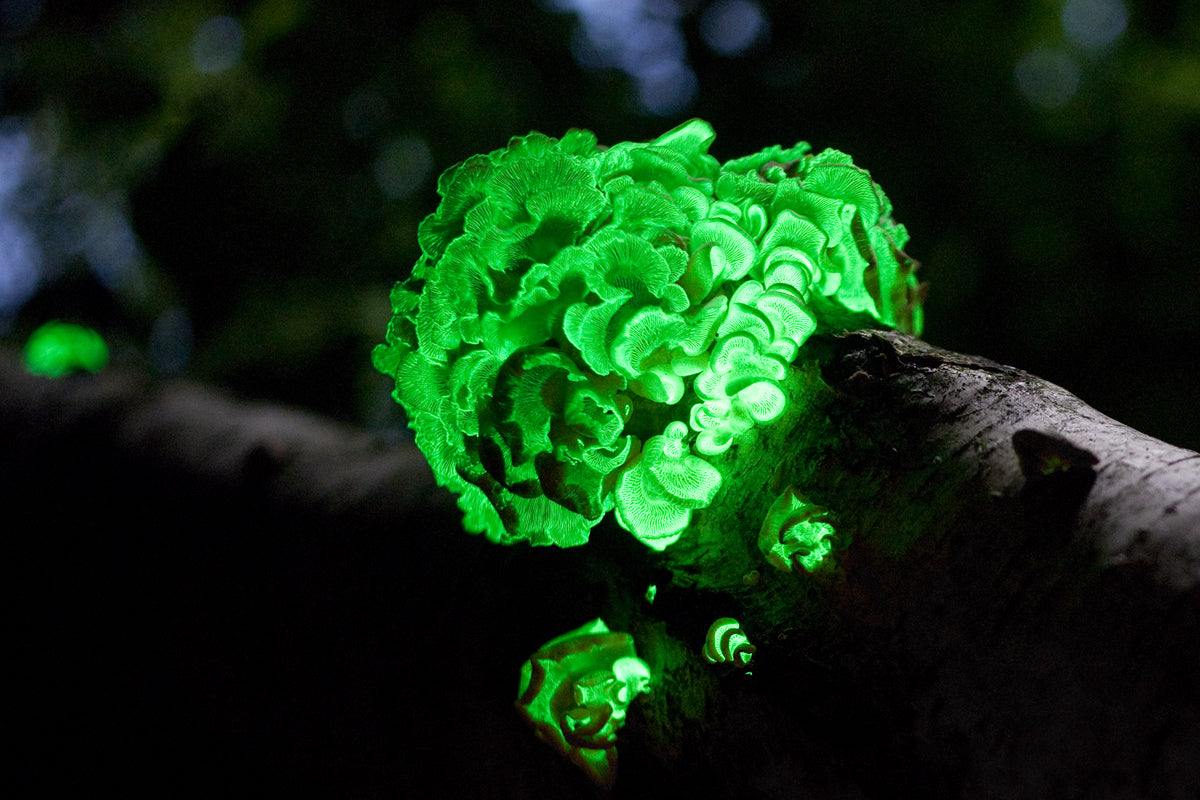
Fungal Luminescence
The saprobe Panellus Stipticus displaying bioluminescence. Image courtesy of Wikipedia.
Here in the Northwest mushroom season is finally in full-swing. October rains beckon mushroamers off trails and into the woods, in search of the elusive Matsutake and delicious Chanterelle. With days growing shorter, the truly be-mushroomed are often caught by surprise in the dwindling evening light. While seeking to return to the safe glow of Jack-o-lanterns and Halloween decorations, many have discovered the ghostly glow of other beings in the dark.
Once regarded as magic, this fascinating phenomenon manifests the bioluminescence of certain species of fungi, sometimes visible at night in forests. Fungal luminescence has appeared throughout written history: A “cold fire of decaying wood” was first observed by Aristotle, then Pliny the Elder, and later (c.a. 1500) the ethereal glow was called "Foxfire" possibly derived from fols, an Old French word for false. Other names for these specters of the dark are “will-o’-the-wisp” or “faerie fire.” Naturalists in the early 19th century identified one source to be fungi growing on wooden supports in mine shafts, and in Mark Twain’s Huckleberry Finn, the character Tom Sawyer used the light of Foxfire to dig a tunnel.
In the late 1800s a French chemist extracted and named the heat-stable compound "luciferin" (meaning light bringer) which glowed in combination with the heat-labile enzyme "luciferase". In fact, still today glowing substances are generally termed "luciferins" and their corresponding enzymes "luciferases." This experiment was repeated in the early 20th century with hot (Luciferin) and cold (Luciferase) water extracts of luminous fungi, however the biochemistry remained unclear. In 2015, a breakthrough by Russian and Japanese scientists showed that hot water extracts of non-luminescent fungi glowed when mixed with enzyme-containing cold water extracts from luminescent fungi. This illustrates a few things: first that non-glowing fungi also contained the luciferin precursor (a fungal metabolite known as hispidin.) And second, Bioluminescent fungi require not only hispidin, but also the ability to produce two specific enzymes: one to convert hispidin to actual luciferin, and the other to catalyze the oxidative reaction that produces the bluish-green glow of Foxfire.
Curiously enough, all roughly 80 luminescent species of fungi are white-rot fungi, which use a different oxidative process to degrade lignin and other compounds in wood. Their similar biochemistry may provide clues to help further characterize both physiological and ecological functions of bioluminescence. Though the role of luminescence in the life cycle of these fungi is still unknown, mycologists theorize that the reaction may release extra energy, protect tissue from oxidation, or attract insects which then help disperse the spores of the mushroom.
Although Fungi Perfecti does not offer any glowing varieties of mushroom or mycelium, we have historically experimented with bioluminescent fungi. The most common glowing fungi, Armillaria sp (Honey Mushroom) and the largest organism on earth is unfortunately parasitic, and we do not condone the cultivation or deliberate spread of parasitic fungi.
To observe this fungal phenomenon, head into the woods on a new moon, avoiding light pollution, and turn off your flashlight. Once the sky fades to black, you might see the cold light of Foxfire glowing faintly around you.
Sources:
Coder, 1999. Foxfire: Bioluminescence in the Forest - University of Georgia School of Forest Resources available here.
Wikipedia
The Chemical Basis of Fungal Bioluminescence
